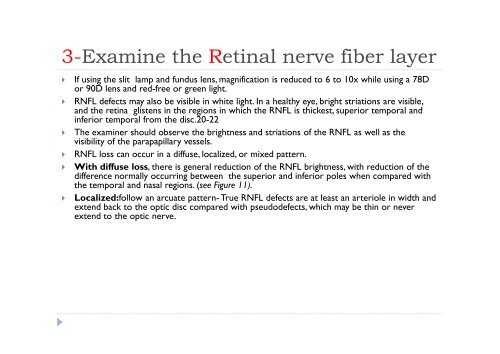Evaluation of optic disc in glaucoma
Evaluation of optic disc in glaucoma
Evaluation of optic disc in glaucoma
Create successful ePaper yourself
Turn your PDF publications into a flip-book with our unique Google optimized e-Paper software.
3-Exam<strong>in</strong>e the Ret<strong>in</strong>al nerve fiber layer<br />
If us<strong>in</strong>g the slit lamp and fundus lens, magnification is reduced to 6 to 10x while us<strong>in</strong>g a 78D<br />
or 90D lens and red-free or green light.<br />
RNFL defects may also be visible <strong>in</strong> white light. In a healthy eye, bright striations are visible,<br />
and the ret<strong>in</strong>a glistens <strong>in</strong> the regions <strong>in</strong> which the RNFL is thickest, superior temporal and<br />
<strong>in</strong>ferior temporal from the <strong>disc</strong>.20-22<br />
The exam<strong>in</strong>er should observe the brightness and striations <strong>of</strong> the RNFL as well as the<br />
visibility <strong>of</strong> the parapapillary vessels.<br />
RNFL loss can occur <strong>in</strong> a diffuse, localized, or mixed pattern.<br />
With diffuse loss, there is general reduction <strong>of</strong> the RNFL brightness, with reduction <strong>of</strong> the<br />
difference normally occurr<strong>in</strong>g between the superior and <strong>in</strong>ferior poles when compared with<br />
the temporal and nasal regions. (see Figure 11).<br />
Localized:follow an arcuate pattern- True RNFL defects are at least an arteriole <strong>in</strong> width and<br />
extend back to the <strong>optic</strong> <strong>disc</strong> compared with pseudodefects, which may be th<strong>in</strong> or never<br />
extend to the <strong>optic</strong> nerve.
















